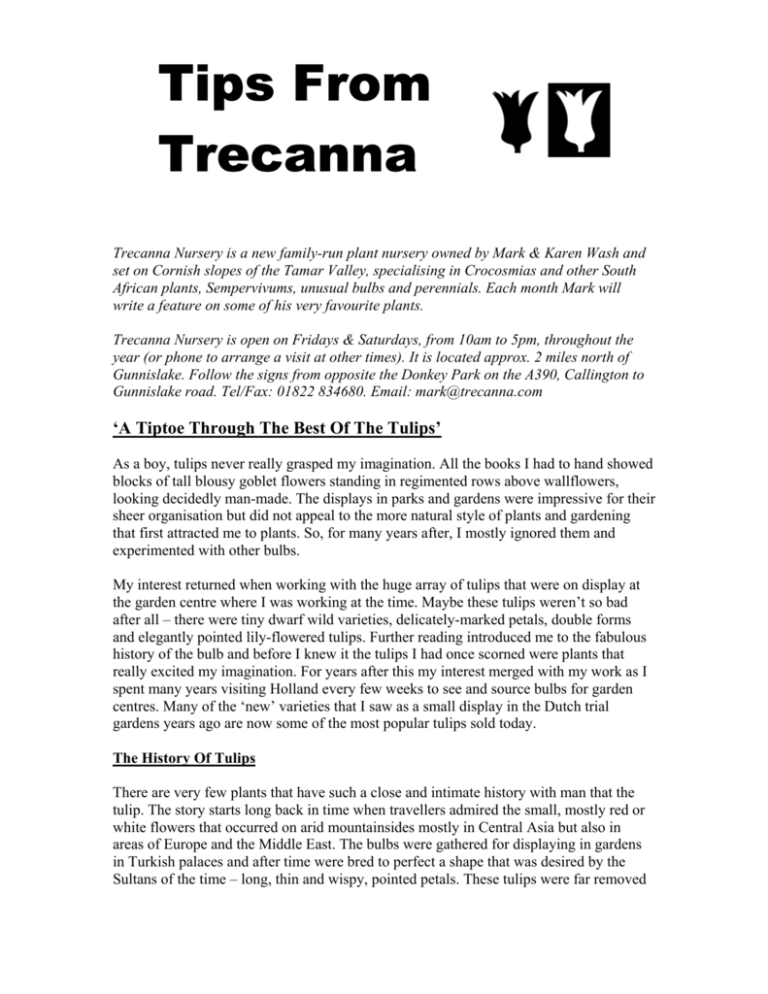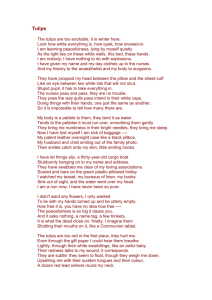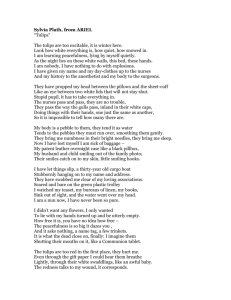Tulips - Trecanna Nursery
advertisement

Tips From Trecanna Trecanna Nursery is a new family-run plant nursery owned by Mark & Karen Wash and set on Cornish slopes of the Tamar Valley, specialising in Crocosmias and other South African plants, Sempervivums, unusual bulbs and perennials. Each month Mark will write a feature on some of his very favourite plants. Trecanna Nursery is open on Fridays & Saturdays, from 10am to 5pm, throughout the year (or phone to arrange a visit at other times). It is located approx. 2 miles north of Gunnislake. Follow the signs from opposite the Donkey Park on the A390, Callington to Gunnislake road. Tel/Fax: 01822 834680. Email: mark@trecanna.com ‘A Tiptoe Through The Best Of The Tulips’ As a boy, tulips never really grasped my imagination. All the books I had to hand showed blocks of tall blousy goblet flowers standing in regimented rows above wallflowers, looking decidedly man-made. The displays in parks and gardens were impressive for their sheer organisation but did not appeal to the more natural style of plants and gardening that first attracted me to plants. So, for many years after, I mostly ignored them and experimented with other bulbs. My interest returned when working with the huge array of tulips that were on display at the garden centre where I was working at the time. Maybe these tulips weren’t so bad after all – there were tiny dwarf wild varieties, delicately-marked petals, double forms and elegantly pointed lily-flowered tulips. Further reading introduced me to the fabulous history of the bulb and before I knew it the tulips I had once scorned were plants that really excited my imagination. For years after this my interest merged with my work as I spent many years visiting Holland every few weeks to see and source bulbs for garden centres. Many of the ‘new’ varieties that I saw as a small display in the Dutch trial gardens years ago are now some of the most popular tulips sold today. The History Of Tulips There are very few plants that have such a close and intimate history with man that the tulip. The story starts long back in time when travellers admired the small, mostly red or white flowers that occurred on arid mountainsides mostly in Central Asia but also in areas of Europe and the Middle East. The bulbs were gathered for displaying in gardens in Turkish palaces and after time were bred to perfect a shape that was desired by the Sultans of the time – long, thin and wispy, pointed petals. These tulips were far removed from the modern tulip and all these varieties have disappeared many hundreds of years ago. Further on in time visitors from Europe admired the colourful blooms growing in these palaces and bulbs were exchanged as part of diplomatic gifts and found their way into France and Holland amongst other places. In 1554. Ghislain be Busbecq, who at the time was the ambassador of the Holy Roman Empire to the Turkish ‘Suleyman The Magnificent’ confused the name with the Turkish ‘tulipam’ (meaning Turban) and the modern name in Europe for this bulb was born. A fascination for the bulbs grew in The Netherlands and after much work with breeding, certain bulbs developed intricate markings on the petals caused by a virus that caused the colours to ‘break’. In Holland the desire for these special bulbs grew so much that in the mid 17th century a period known as ‘Tulipomania’ took place and prices for individual bulbs rocketed to extraordinary levels with individual bulbs selling for prices equivalent to up to £80,000 each. Fortunes were made and then lost when the market finally collapsed in 1637 leaving many traders bankrupt and owing vast sums. Most of the modern hybrids have been bred over the past 100 years but a few examples of earlier varieties still exist – all of these are ‘clean’ from virus and the markings are due to hybridisation. A number of varieties of ‘English Florist Tulips’ are guarded by devotees in northern England – these are virus infected varieties from the 19th century but you will never find any on sale as the numbers are so very few. Of course the wild species originating in Asia have sat there quietly growing away during the mayhem in distant lands and a number of these are now cultivated commercially. How To Grow Tulips Tulips vary in size from just 4 inches (10cm) high to 24 inches (60cm) or more and therefore suit a variety of locations. Taller varieties are good for growing through border plants or close to walls and fences where they can flower and then disappear prior to the main summer display. Dwarf and mid-height varieties (8 to 16 inches) are good in windier places and in containers. Miniature (usually wild) species are good on top of walls, in containers and in rock-gardens. All tulips appreciate full sun and well drained soil. Add plenty of grit to the soil if drainage is a problem of keep to growing in raised beds or containers. If your soil is very acid then an addition of some lime might produce better long term results however, this is not essential. Plant the bulbs around three times as deep as the height of the bulb – this usually means 4-6” deep for hybrids and 3” deep for wild varieties. Plant during October or November – this is later than most other spring flowering bulbs. Watering is usually not required although an occasional dose can help in dry spells as the flower buds develop and open. Feeding is not crucial but it can help with modern hybrids to use a little all-purpose organic feed when planting and a small further dose in March – this can help to improve Page 2 of 5 the flowers for next year. Most important of all is to leave the leaves on until they fully wither away at which point the stem should pull away from the bulb easily. Any seed heads that develop are best pinched out. I leave my tulips in from year to year but you can remove them and lay in a light and dry position until a good skins form. They can then be stored in a cool shed until next Autumn. The wild varieties along with Darwin, Kauffmaniana, Triumph and Greigii types will often clump up if left alone. Tulip Types Due to the vast number of varieties Tulips are split into 15 different groups mainly to define the key characteristics of the flowers as follows: Single Early (Division 1) – Single cup-shaped flowers that flower early. Double Early (Division 2) – Early and mid season double tulips, usually low growing. Triumph Tulips (Division 3) – Cup shaped flowers on stout stems usually with markings at the edges or flecking. Darwin Tulips (Division 4) – Tall and upright with bowl shaped flowers. Single Late (Division 5) – Goblet-shaped, late to flower. Lily-flowered (Division 6) – Elegant pointed petals. Fringed Tulips (Division 7) – Cup shaped flowers with feathered edges. Viridiflora Tulips (Division 8) – Cup or bowl shaped with distinct green markings Rembrandt Tulips (Division 9) – Single flowers with flames and markings similar to the Dutch tulips of ‘Tulipomania’ Parrot Tulips (Division 10) – Bizarre cut a rippled petals forming exotic shapes. Double Late Tulips (Division 11) – Fully double, late flowering and elegant. Kaufmanniana Tulips (Division 12) – Low growing, waterlily-type flowers, often marked leaves. Fosteriana Tulips (Division 13) – Bright single flowered derived from one wild species. Greigii Tulips (Division 14) – Low growing with spreading leaves and single flowers. Miscellaneous Group (Division 15) – Everything else! Includes all wild species. Page 3 of 5 Our Top Ten Tulips Here is a selection of our very favourite tulips to look out for this Autumn. Note that varieties followed wit the initials AGM have bee awarded the Royal Horticultural Society Award Of Garden Merit for outstanding garden performance. 1. Tulipa Angelique. AGM A double late tulip of pastel pink. Very reliable and performs really well in the garden. 2. Tulipa Shirley. An interesting Triumph type tulip that opens with creamy flowers that slowly develop beautiful purples veins as the flower ages. 3. Tulipa biflora. A wild variety with 2 to 3 small white starry flowers with a yellow centre. It has the bonus of being scented and grow just 4” tall (Karens favourite). 4. Tulipa acuminata. One of the only tulips left that resemble the pointed petals of the ancient Turkish tulips of long ago. Everyone should just try a few. 5. Tulipa Carnival De Nice. AGM A late double with white petals and red flames. Looking like it has come straight from an ‘old masters’ painting. It also has the bonus of a creamy/pink edge to the leaves. 6. Tulipa sylvestris – A wild tulip that does actually grow in certain hedgerows in the UK. Beautiful golden-yellow flowers with petals that re-curve back. 7. Tulipa Burning Heart. – Big and bold, this Darwin type tulip has enormous bowl shaped flowers of lemon yellow with striking red flames. It lives up to its name. 8. Tulipa Princess Irene. AGM – A Triumph tulip with orange petals streaked with purple and with rich maroon flames from the base. Excellent in tubs and very long lasting. 9. Tulipa Orange Princess. AGM – A much-overlooked late double tulip with sumptuous petals of tangerine orange with lime-green flushes. A very different variety with the RHS Award of Garden Merit that is not often seen. 10. Tulipa Ballerina. AGM – A Lily-flowered tulip with scented flowers. Its orange petals have red veins that develop as the flower ages and a yellow base. Trecanna Top Tips For Tulips • To provide colour in a border without the sight of old leaves as they die back, plant some tulips into larger 12” pots and place them half buried in the border where other growing plants will hide the pots. Enjoy the flowers, then move the pots to a sunny sheltered place that is out of site to let the leaves die down. • For lower growing varieties in the ground or containers spread a layer of grit over the surface of the soil or compost. This will stop the flowers from being splashed with soil when it rains. • If mice or squirrels are a problem try planting up to 50% deeper than recommended and lay a 12” to 18” wide piece of fine chicken wire 1” above the bulbs. The shoots will grow through but it can save the bulbs from being stolen! Page 4 of 5 I hope that you have enjoyed our tiptoe through the tulips and can find a gap for a few in your garden. A small investment now will bring weeks of joy next spring and you never know when the next ‘Tulipomania’ period will start so your bulbs may even become worth more than you can possibly dream! Happy Gardening! ENDS Page 5 of 5








